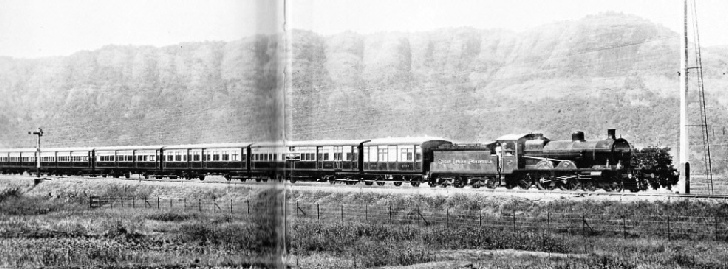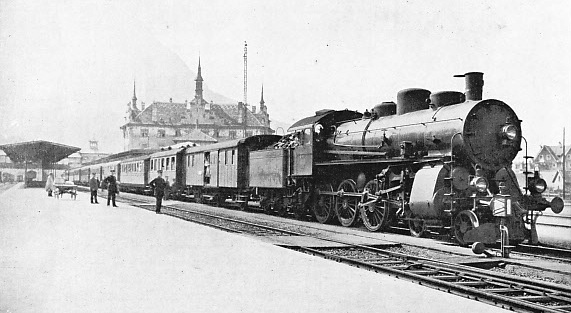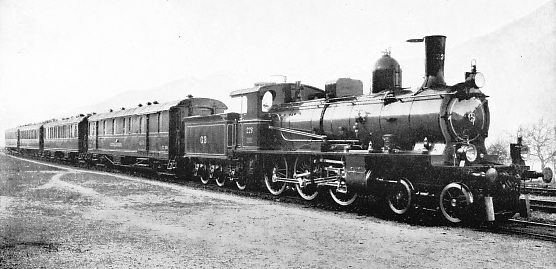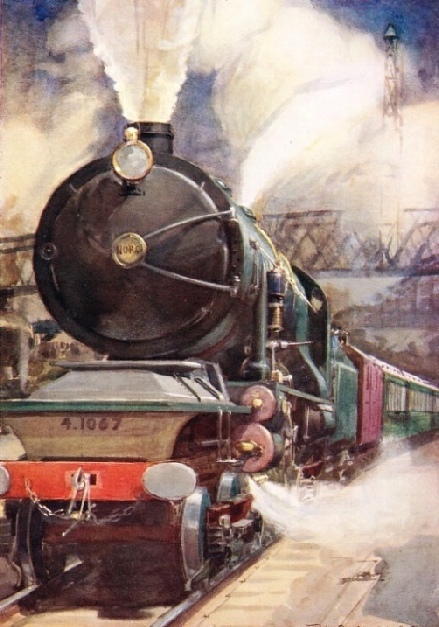
© Railway Wonders of the World 2012-


Famous Expresses - 4
Some Continental and Indian Trains de Luxe

THE “PENINSULA” OR “TOURISTS’ HOTEL” EXPRESS OF THE GREAT INDIAN PENINSULA RAILWAY
This train inaugurates a new era in Indian railway travel and gives the maximum comfort and luxury to tourists. The travellers live on the train, which moves from point to point during the night.
THE remarkable growth of traffic between London, Switzerland, and points beyond has been responsible for an increased demand for locomotive effort among the different countries through which this flow of traffic passes. This development has been particularly noticeable in Switzerland, where the heavy grades among the mountains exercise such an adverse effect. Notwithstanding this handicap it is possible to cover the 842 miles between the English capital and Milan by means of the crack expresses in 24-
The Swiss Government has assiduously cultivated fast travelling over the lines under its control, inasmuch as it is threatened by the French route to Italy which goes by way of the Cenis Tunnel. During the past few years more and more powerful locomotives have been designed. They are of the 4-
The most powerful Swiss express locomotives are four-
The engines engaged in pilot service have high-
The maximum travelling speeds of trains in Switzerland are controlled rigidly by law, and the steps taken to ensure these maxima not being exceeded are of an elaborate character. The supply of a tachometer in the cab of the engine is compulsory for the assistance and guidance of the driver. The speeds which are set down can only be exceeded by special arrangement, which, it may be mentioned, is not extended readily. The restrictions vary, but are specified under one of three broad headings. Passenger trains fitted with continuous automatic brakes are allowed to attain a maximum speed of 72 miles per hour so long as the number of axles does not exceed 44. With from 45 to 52 axles the speed is reduced to 60, and from 53 to 60 axles is restricted to 52 miles per hour. Trains which are not fitted with a continuous brake have their maximum speeds reduced somewhat severely, those in passenger service up to 60 axles and goods trains up to 120 axles being permitted to run at 36 miles per hour.
Curves and gradients also affect the issue. While an automatically braked passenger train may attain a speed of 68 miles per hour on a bank ranging from 1 in 100 to 1 in 80, it must not exceed 40 miles an hour on gradients ranging from 1 in 36 to 1 in 33. The speed round curves is graduated in a similar manner. On curves ranging from 1,640 to 1,475 feet in radius 58 miles per hour are allowed, but on curves ranging from 656 to 577 feet in radius the speed is restricted to 40 miles per hour. Where a line has curves of less than 577 feet radius or banks heavier than 1 in 33 the authorities make special arrangements. As the tachometers are designed to give a continuous graphic record of the speeds attained throughout a journey, and as their working is automatic, tampering is impossible.

THE ST. GOTTHARD EXPRESS HAULED BY THE LATEST TYPE OF 4-
India is claiming an increasing number of visitors every year, and an innovation which will meet with the greatest appreciation has been introduced by the Great Indian Peninsula Railway. This is the “Peninsula Express”, or, to quote its colloquial title, the “Tourists’ Hotel” train, which has been provided as a compensation for the indifferent hotel accommodation available in the smaller cities of Upper and Central India. In order to attract the travelling public to the wonders of our Indian Empire the management of the Great Indian Peninsula Railway realised that some special effort was necessary. The carriages of this train de luxe are of the very latest vestibuled type, and it is, in fact, a “club on wheels”, with every possible convenience to be found in a first-
Visitors to India who travel over this system, and who take advantage of this travelling hotel, practically live on the train during the whole of their trip. As a ride it moves from point to point in accordance with a planned itinerary, the departure from one centre for another being timed in the evening about the dinner hour. This gives ample opportunity during the day for sight-
Special attention has been devoted to the designing and equipment of the sleeping accommodation to ensure the utmost pleasure and comfort. The “sleepers” are built upon the corridor principle, with both longitudinal and transverse berths arranged in cabins for two or four occupants. In this manner absolute privacy is assured, while each cabin is fitted with electric light, fans, ample space for hand-
The personal baggage of the passengers is carried in the front vehicle, which is a combination car. Here it is stored in cloak rooms under the care of a conductor, and whenever necessary a particular bag or trunk can be discovered instantly. This combination car also contains compartments for the accommodation of the private servants of the travellers, a fully equipped bathroom, and a number of private dressing-

4-
The “parlour” car offers a seductive smoking lounge, a dainty ladies’ boudoir, and a general reception-
The “restaurant” car, capable of seating 40 persons, is of imposing dimensions. The separate tables are lighted by bracket electroliers, while a number of powerful electrically driven punkahs ensure a cool, refreshing atmosphere. There is a commodious kitchen fitted with a large gas cooking range, grill, boilers, etc. A pressure filter of large capacity secures a constant illimitable supply of cool, filtered water. All stores, provisions, and ice are carried in a store van adjacent to the kitchen, which also offers accommodation for the train crew, attendants, and other servants.
Special attention has been devoted to efficient and adequate ventilation, while the roofs and sides are double, with a layer of heat-
 Among European railways the expresses of the Chemin de Fer du Nord compel attention, because they offer striking expressions of fast railway travelling. Many of the crack trains upon this system attain and exceed an average speed of 56½ miles per hour. Pride of place, however, is held by No. 197, in the Paris-
Among European railways the expresses of the Chemin de Fer du Nord compel attention, because they offer striking expressions of fast railway travelling. Many of the crack trains upon this system attain and exceed an average speed of 56½ miles per hour. Pride of place, however, is held by No. 197, in the Paris-
DEPARTURE OF THE NORD EXPRESS
The French “flyers” of the Chemin de Fer du Nord, hauled by powerful “Baltics” (4-
The average load hauled by the locomotives in the Paris-
These crack trains are hauled by the well-
[From Part 18 of Railway Wonders of the World by Frederick A. Talbot, 1913]
You can read more on “Famous Expresses 2”, “The Great St Gothard”, “The Northern Railway of France” and “Speed Trains of Europe” on this website.